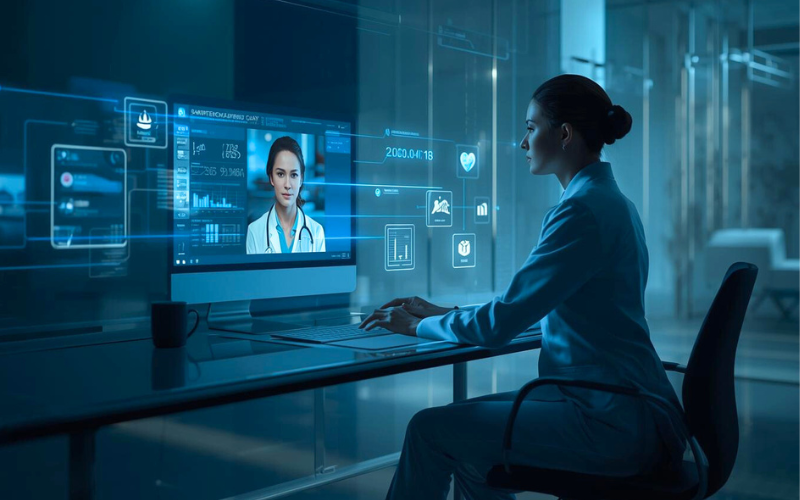Introduction: The Digital Transformation of Medicine
Telemedicine has evolved from a niche solution into a central pillar of modern healthcare delivery. Enabled by secure digital platforms, wearable technologies, and real-time data exchange, telemedicine bridges the gap between clinicians and patients across distances. As adoption accelerates, it is enhancing accessibility, streamlining care delivery, and transforming the med-tech landscape.
This article explores how telemedicine is reshaping patient care, improving outcomes and opening new opportunities for innovation across specialties.
1. Understanding Telemedicine
Three Core Delivery Models
Telemedicine provides remote clinical services through:
- Synchronous Consultations: Real-time video or phone-based care.
- Asynchronous Communication: Secure exchange of medical data (e.g., test results, images).
- Remote Patient Monitoring (RPM): Continuous health data collection via connected devices.
Result: These models collectively expand healthcare access, especially for rural, elderly or mobility-limited patients.
2. Improving Access, Efficiency and Continuity
Breaking Down Barriers to Care Level
Telemedicine:
- Eliminates Travel Barriers: Connects patients to specialists regardless of location.
- Reduces Clinical Backlogs: Cuts in-person appointments, easing staff workload.
- Enables Faster Follow-Ups: Speeds diagnosis, treatment updates and prescription access.
Real-World Impact: During COVID-19, tele health usage rose by over 400%, validating its scalability and resilience.
3. Key Telemedicine Applications by Specialty
A. Tele-Ophthalmology
- Remote screening for diabetic retinopathy and glaucoma via AI-enhanced imaging.
- Post-op monitoring after cataract or retinal surgeries.
- Patient education tools to explain treatment plans visually.
Impact: Improves access to specialist eye care, especially in underserved areas.
B. Tele-Cardiology
- Wearables and smart ECGs enable 24/7 heart monitoring.
- Real-time alerts prevent cardiac emergencies.
- Reduces hospital readmissions and improves post-op outcomes.
Example: Remote cardiac monitoring has cut hospitalisations by up to 20% in some studies.
C. Tele-Neurology & Tele-Rehabilitation
- Enables stroke recovery, Parkinson’s management and MS care through remote assessments.
- Virtual rehab platforms enhance therapy adherence.
Benefit: Expands neuro care access to patients in remote or mobility-limited conditions.
D. Tele-Dermatology
- Patients upload high-resolution images for rapid dermatological evaluations.
- Useful for diagnosing rashes, lesions, acne and chronic skin conditions.
Result: Reduces waiting times by up to 60% for dermatology consultations.
4. Benefits for Providers and Patients
For Providers:
Automation supports diverse therapeutic areas:
- Improved scheduling efficiency and reduced no-shows.
- Lower operational overhead.
- Enhanced clinical decision-making through EMR integration.
For Patients:
- Convenience: Access care from home.
- Cost Savings: Lower travel and appointment costs.
- Better Outcomes: Continuous follow-up improves compliance.
5. Challenges in Telemedicine Integration
Despite its growth, telemedicine faces hurdles:
- Data Security: Protecting patient data and adhering to privacy regulations.
- Digital Literacy Gaps: Some patients lack access or familiarity with digital tools.
- Licensing & Reimbursement: Regulatory inconsistencies across borders.
- Clinical Limitations: Some diagnoses still require physical examination.
Ongoing collaboration among med-tech companies, providers, and regulators is essential for overcoming these barriers.
6. The Future of Telemedicine: A Connected Ecosystem
Next-Gen Innovations Include:
- AI-Powered Diagnostics: Algorithms identify abnormalities in images or vital data.
- IoT-Driven Monitoring: Wearables transmit real-time data for chronic disease management.
- Global Care Models: Patients access international consultations and second opinions.
- Hybrid Healthcare Delivery: Merging digital and in-person care for comprehensive solutions.
Vision: A data-driven, globally connected healthcare model centered on patient empowerment.
7. Telemedicine in the Med-Tech Industry
A Booming Market Opportunity
The global telemedicine market is forecast to surpass $460 billion by 2030. For med-tech manufacturers, this growth presents opportunities to:
- Develop secure and scalable telehealth platforms.
- Create diagnostic tools integrated with real-time data sharing.
- Enable research and training through global tele-collaboration.
Impact: Telemedicine is not just transforming care it is reshaping how med-tech companies innovate and compete.
Conclusion: Remote, Personalised and Scalable Care
Telemedicine is now a core component of modern healthcare. By combining digital connectivity with clinical expertise, it delivers efficient, patient-centered care across disciplines.
From ophthalmology to cardiology and beyond, telemedicine empowers patients and providers alike.





